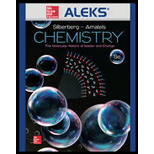
Concept explainers
Interpretation:
Each number is to be rounded off to one fewer significant figures and the answer of the following calculation is to be calculated.
Concept introduction:
Significant figures of a number are the digits which carry meaningful contribution to its measurement resolution. The rightmost digit of the quantity is the most uncertain digit. The number of certain and uncertain digit in a quantity is considered as significant figures. The digit with a higher number of significant figures has a higher certainty of measurement.
To determine the number of significant figures in a quantity following steps is followed.
1. The quantity must has a decimal point.
2. Start counting from the left and proceed towards the right until the first nonzero digit is encountered. All nonzero digit and the zeroes between two nonzero digits are considered as significant figures. For example, 0.0000765 has three significant figures and 7009 has four significant figures.
3. Zeroes after a decimal point are significant figures. For example, 42.0 have three significant figures.
4. Trailing zeroes that do nothing but are used to set a decimal point are non-significant figures. However, exponential notation can be used to avoid confusion. For example, 4300 has 3 significant figures. It can be expressed in scientific notation as
5. Zeroes present before a trailing decimal point are significant figures. For example, 3200 has only two significant figures but 3200. has 4 significant figures.
Rules to determine significant figures in calculations are as follows:
(1) In multiplication and division operations the result carries the same number of significant figures as the operand or measurement with the fewest significant figures.
(2) In addition and subtraction operations, the result carries the same number of decimal places as the operand or measurement with fewest decimal places.
(3) Exact numbers do not affect the number of significant digits in the final answer.
In mathematical expression which involves mixed operations the result of each intermediate step with proper significant figures. Avoid rounding of the result at intermediate steps. Round off the final answer of the calculation. The rules to round off are as follows:
(1) If the last dropped digit is greater than 5 then increase the preceding digit by 1.
(2) If the last dropped digit is less than 5 then the preceding digit does not change.
(3) If the last digit dropped is 5, then the preceding digit is increased by 1 if it is odd and remains the same if it is even. Also, if 5 is followed by zeroes only then rule (3) is applicable and if it is followed by non-zero digit then rule (1) is applicable.
Want to see the full answer?
Check out a sample textbook solution
Chapter 1 Solutions
CHEMISTRY:MOLECULAR NATURE...-ALEKS 360
- b. CH3 H3C 'N' H3C CH3 CN Ph 1. OH N 2. H2O2, Pyridinearrow_forwardFor each of the Followin, moleaks draw all OF The Resonance contributing stuluctures and compare these three molecules in terms of Resonance stabilization 1-C-1 a. b. H A-C+ О 112-1 C. F-C-F Farrow_forwarda. Explain Why electron withdrawing groupe tend to be meta-Directors. Your answer Should lyclude all apropriate. Resonance contributing Structures 6. Explain why -ll is an ortho -pura drccton evon though chlorine has a very High Electronegativityarrow_forward
- Question 1. Please predict the products for each of the following reactions. Clearly show the regiochemistry (Markovnikov vs anti-Markovnikov) and stereochemistry (syn- vs anti- or both). If a mixture of enantiomers is formed, please draw all the enantiomers.arrow_forwardElectrochemistry. Briefly describe the Donnan potential.arrow_forwardIndicate what the Luther equation is used for?arrow_forward
- Indicate one aspect that benefits and another that makes it difficult to use the hydroquinone electrode to measure pH.arrow_forwardAt an electrified interface according to the Gouy-Chapman model, what types of interactions do NOT occur between the ions and the solvent according to this theory?arrow_forwardPlease predict the products for each of the following reactions. Clearly show the regiochemistry (Markovnikov vs anti-Markovnikov) and stereochemistry (syn- vs anti- or both). If a mixture of enantiomers is formed, please draw all the enantiomers. Hint: In this case you must choose the best answer to demonstrate the stereochemistry of H2 addition. 1.03 2. (CH3)2S BIZ CH₂OH 2. DMS KMnO4, NaOH ΖΗ Pd or Pt (catalyst) HBr 20 1 HBr ROOR (peroxide) HO H-SO HC 12 11 10 BH, THE 2. H2O2, NaOH Brz cold HI 19 18 17 16 MCPBA 15 14 13 A Br H₂O BH3⚫THF Brz EtOH Pd or Ni (catalyst) D₂ (deuterium) 1. Os04 2. H2O2 CH3CO3H (peroxyacid) 1. MCPBA 2. H₂O* H B + H H H "H C H H Darrow_forward
 ChemistryChemistryISBN:9781305957404Author:Steven S. Zumdahl, Susan A. Zumdahl, Donald J. DeCostePublisher:Cengage Learning
ChemistryChemistryISBN:9781305957404Author:Steven S. Zumdahl, Susan A. Zumdahl, Donald J. DeCostePublisher:Cengage Learning ChemistryChemistryISBN:9781259911156Author:Raymond Chang Dr., Jason Overby ProfessorPublisher:McGraw-Hill Education
ChemistryChemistryISBN:9781259911156Author:Raymond Chang Dr., Jason Overby ProfessorPublisher:McGraw-Hill Education Principles of Instrumental AnalysisChemistryISBN:9781305577213Author:Douglas A. Skoog, F. James Holler, Stanley R. CrouchPublisher:Cengage Learning
Principles of Instrumental AnalysisChemistryISBN:9781305577213Author:Douglas A. Skoog, F. James Holler, Stanley R. CrouchPublisher:Cengage Learning Organic ChemistryChemistryISBN:9780078021558Author:Janice Gorzynski Smith Dr.Publisher:McGraw-Hill Education
Organic ChemistryChemistryISBN:9780078021558Author:Janice Gorzynski Smith Dr.Publisher:McGraw-Hill Education Chemistry: Principles and ReactionsChemistryISBN:9781305079373Author:William L. Masterton, Cecile N. HurleyPublisher:Cengage Learning
Chemistry: Principles and ReactionsChemistryISBN:9781305079373Author:William L. Masterton, Cecile N. HurleyPublisher:Cengage Learning Elementary Principles of Chemical Processes, Bind...ChemistryISBN:9781118431221Author:Richard M. Felder, Ronald W. Rousseau, Lisa G. BullardPublisher:WILEY
Elementary Principles of Chemical Processes, Bind...ChemistryISBN:9781118431221Author:Richard M. Felder, Ronald W. Rousseau, Lisa G. BullardPublisher:WILEY





